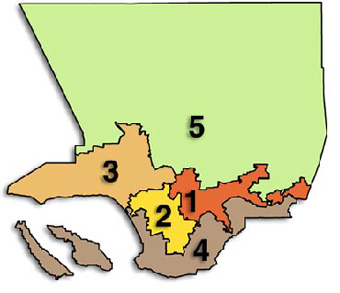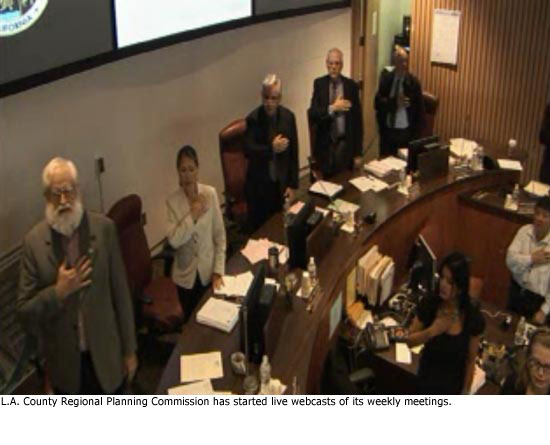Board Business
Redistricting in your PJs
April 28, 2011
 Welcome to Redistricting, 2011—the home edition.
Welcome to Redistricting, 2011—the home edition.
This year, for the first time, Los Angeles County is giving the public the technological tools to create its own boundaries for the five supervisorial districts, using an impressive array of demographic and voting data to ensure each is drawn equitably.
“I’ve never seen this amount of information pulled together about the county on any website,” said Assistant Chief Executive Officer Martin Zimmerman, who is overseeing support staff for the redistricting effort.
The new do-it-yourself mapping feature is just one facet of a legally mandated undertaking that occurs every 10 years, following the federal census. The districts must be drawn to ensure fair representation on the Board of Supervisors, complying with the U.S. Constitution, federal Voting Rights Act, County Charter and California Elections Code. Each district must have an equal number of residents—roughly 2 million.
The board is expected to approve by August any changes to the existing boundaries, based on recommendations from the Boundary Review Committee, or BRC, whose members are appointed by the supervisors. A series of public meetings are now being held throughout the county. In the Third District, one will be held on Monday, May 2, at Van Nuys High School, and another will be convened on Monday, May 9, at West Hollywood Park Auditorium. Both will take place from 6 p.m. to 8 p.m. The BRC encourages public comment at these meetings and via e-mail through the county’s new redistricting website.
In preparing its recommendations for the Board of Supervisors, the committee also will study plans submitted by the public—a job that could be more challenging this time around.
Ten years ago, technology was far less sophisticated and accessible. Facebook billionaire Mark Zuckerberg was still in high school, for example, and dial-up Internet access remained popular in homes across America. Back then, the county installed mapping programs on computers it made available to the public at the Hall of Administration in downtown Los Angeles and at the county’s Public Works Department in Alhambra. Participation was not brisk.
But this time around, with the advent of high-speed connections and cutting-edge database technology, the county entered into a contract with a “geographic information systems” company called Esri to supply the software for home-drawn versions.
Given the depth and variety of information (there’s more than 20 racial breakdowns alone), county officials recommend that anyone interested in submitting their own redistricting plans should first participate in an online training session.
Even if you don’t want to submit a plan, the databases provide an unprecedented one-stop view of the county’s diverse cities and communities down to the census tract level, including not only race but also income, homeownership status, languages spoken at home, voting histories on past issues, party affiliation and gender, to name a few.
Said Assistant CEO Zimmerman: “It’s a treasure trove.”
Posted 4/28/11
Checking for county cell phone static
January 4, 2011

With more than 17,000 cell phones, Blackberries and other mobile communications devices out there in the hands of Los Angeles County employees, supervisors sent a loud and clear signal to department heads Tuesday:
Look who’s talking—and make sure that the public isn’t being stuck with any unwarranted roaming, texting, directory assistance and other service charges.
On the heels of an audit that found widespread cell phone abuse and lax oversight in the Department of Children and Family Services, supervisors voted to initiate a countywide policy to make sure proper controls are in place across the county’s entire mobile communications network. There currently is no centralized oversight of the county’s cell phones; instead, that responsibility falls to individual departments.
It’s a big responsibility—and it’s growing. An inventory of handheld communication devices by the county’s Chief Information Office forecasts that the number of cell phones and similar devices being used by county workers will grow from 17,657 this fiscal year to 19,304 in the next one.
Supervisors, acting on a motion by Michael D. Antonovich and Gloria Molina, on Tuesday directed all county department heads to conduct internal reviews of their cell phone control practices and report back on whether they found any issues similar to those that turned up in the DCFS audit.
That probe found at least $514,000 in potentially inappropriate charges as well as 250 cell phones whose users could not be identified and 1,400 cell phones that were running up monthly service fees even though they weren’t being used. One employee racked up more than $2,000 in personal international calls but did not reimburse the department, while another’s phone was linked to $8,000 in service charges, including roaming charges from Mexico. Still another employee ran up $2,827 in texting charges over the course of a year.
DCFS reported a combined total of 3,699 cell phones and Blackberry/PDA devices in the Chief Information Office’s inventory—nearly 21% of the county total. The department spends about $2.2 million a year on its cell phones. The county’s overall spending on mobile devices could not immediately be determined. A Chief Executive Office analysis to determine whether the county would save money by giving employees a stipend for cell phones, instead of paying the bills directly, was launched before the DCFS audit came out but has not been completed.
The motion passed by supervisors on Tuesday also directed the county Auditor-Controller, which conducted the DCFS audit, to cast its net more broadly in the next 12 months to ensure that various county departments have enacted cell phone policies and controls and are complying with them. And it asked for a progress report in 30 days on how the DCFS is progressing on implementing reform recommendations spelled out in the Auditor-Controller’s audit.
Posted 1/4/11
Let the meeting come to you
November 4, 2010
Interested in keeping up with important decisions affecting the environment and land use in L.A. County? Regional Planning Commission meetings are now just a mouse click away. It’s no longer necessary to dig through pages of transcripts to see what happened, and you won’t need to make a long trek across town to show up in person, either. Beginning this week, live and recorded Regional Planning meetings will be available online, in living color, at http://planning.lacounty.gov/video.
The Regional Planning Commission covers many issues that affect residents in unincorporated areas of the Third District. Upcoming decisions include adopting a new general plan for Los Angeles County, which will literally shape unincorporated communities for generations to come. It will affect how much development will occur in sensitive natural environments countywide, as well as developments affecting individual neighborhoods from Topanga Canyon to Universal City.
Systems analyst Dennis Slavin spearheaded the effort to update the technology of the meeting room and offer a bird’s-eye view of the meetings to the public. His goal was to make it easier for residents to participate, and to improve the transparency and efficiency of the process. When he took on the project, the room’s technology had not been updated in nearly a half-century. Presentations involved paper maps that were difficult to see even for those present at the meetings. Now, “meetings include visual presentations and GIS mapping, a full production that will provide a quality presentation to the public,” Slavin says.
In addition to streaming video of the meeting, the webcasts also allow viewers to get a close-up look at materials being presented and to access documents like the meeting agenda from the same screen.
You can sample the new technology by tuning in to the next commission meeting, on Wednesday, November 10.
Posted 11/4/10
Boycott measure takes aim at Arizona law [updated]
June 1, 2010
 A sharply divided Board of Supervisors on Tuesday approved a Los Angeles County boycott of Arizona—potentially halting millions of dollars in contracts and investments to protest the state’s controversial new illegal immigration law.
A sharply divided Board of Supervisors on Tuesday approved a Los Angeles County boycott of Arizona—potentially halting millions of dollars in contracts and investments to protest the state’s controversial new illegal immigration law.
The Arizona law, which requires law enforcement officers to check the immigration status of those they suspect are in the country illegally, has become an international lightning rod. Tuesday’s vote turned the Hall of Administration meeting room into a forum for the array of divergent viewpoints that have sprung up since it was signed into law.
That was clear when, moments after the vote, one section of the audience chanted “yes we can,” while another shouted “shame on you.”
The board’s 3-2 vote was based on a motion by Supervisors Gloria Molina and Zev Yaroslavsky, who expressed concerns that the Arizona law, set to take effect next month, will lead to “widespread racial profiling and will subject many ‘foreign-looking’ persons and persons of color—including countless U.S. citizens, legal residents, visiting business persons and tourists—to unlawful interrogations, searches, seizures and arrests.”
During their remarks before the vote, Molina and Yaroslavsky both said they conceivably could find themselves unjustly placed under scrutiny in Arizona.
“You only have to look at me to know that I’m one of those individuals who would have a heck of a tough time in Arizona,” Molina said.
Yaroslavsky argued that anyone whose name sounds foreign, like his, or has an accent, could “be ripe for questioning” if they’re pulled over in the desert, forced to provide a birth certificate or passport to prove their citizenship. “That’s nonsense,” he said. “That’s unconstitutional.”
Joining Yaroslavsky and Molina in approving the motion was Supervisor Mark Ridley-Thomas, who did not discuss his views on Arizona’s law or on the merits of the board’s action. Rather, he said simply he’d let his vote speak for itself. Later, in a press release he said he voted for the boycott to help “bring an end to this civil rights crisis and restore fairness under the law.”
Voting against the measure were Supervisors Don Knabe and Michael D. Antonovich, who last week called the proposed boycott “stupid.” On Tuesday, Antonovich argued that Arizona was forced into action because the federal government had failed to enforce the nation’s immigration laws. “The state of Arizona has said out loud: the emperor has no clothes,” Antonovich said.
Knabe, meanwhile, criticized his colleagues for spending time on an issue that, he said, was irrelevant to the needs of L.A. county residents.
The measure instructs staff to report back in two weeks on how—and how soon—the county might legally end its contracts with Arizona companies without harming the county’s interests. It orders a similar review of investments in Arizona securities held by the county and by the Los Angeles County Employees Retirement Association (LACERA.)
A preliminary study by the Auditor Controller’s Office indicates that Los Angeles County agencies have spent $121.3 million over the past five years on goods and services from companies with Arizona addresses. The contracts range in size from a few hundred dollars to many millions, providing the county with everything from Taser guns to landscaping products to waste hauling.
The extent of county contracts in Arizona—including whether the companies are truly based in that state—is still being researched, with a final tally yet to come.
Among the largest expenditures was the nearly $14.8 million paid to Tucson-based Sunquest Information Systems since fiscal 2005. “We do value the business we do in Los Angeles County and we want to continue to do business with our partners in the county,” Kelly Feist, vice president of marketing for the laboratory testing and technology company, said Tuesday.
Feist added that while the company is based in Arizona, it also has offices in North Carolina, England and India. “Most of our employees reside outside of the state of Arizona,” she said.
As for investments, the county holds no stock in Arizona-based companies or in Arizona state or municipal bonds, said Doug Baron, a division chief for the Treasurer Tax Collector, a department that oversees the county’s $25 billion investment portfolio. Baron said the county portfolio does contain “commercial paper”—short term money-market notes issued by banks and corporations—issued by companies that do business in Arizona. It may also hold commercial paper on Arizona-based companies, Baron said Tuesday.
Under the measure, county travel to Arizona also will be suspended unless the trip would “seriously harm the county’s interests,” and directs departments whenever possible to refrain from entering into new contracts with businesses in the state as long as the law is in effect.
In addition to putting a financial squeeze on Arizona, the boycott measure seeks to exert political and legal pressure. It instructs the county’s Chief Executive Officer to send a letter to elected officials in Arizona opposing the law and directs the County Counsel to file a brief in U.S. District Court supporting litigation that challenges the law’s constitutionality.
In addition, it directs the county’s federal legislative advocates to lobby against the use of federal funds to support implementation of the Arizona law.
The supervisors’ action comes after the Los Angeles City Council last month banned most city travel to Arizona and future contracts with firms located in the state. The city’s partial boycott did not, however, cancel all of the city’s contracts with Arizona companies.
The vote came after a parade of speakers testified on both sides of the issue, prompting some vocal responses from the small but engaged audience. Molina, the board’s chair, repeatedly admonished the audience to stop interrupting the speakers.
Those testifying Tuesday ranged from Sheriff Lee Baca (who opposes the Arizona law) to the family of Jamiel Shaw Jr., killed in 2008 by an illegal immigrant gang member, who told the board they support the Arizona law and oppose L.A. County’s boycott.
Posted 6/1/10
Updated 6/18/10
Implementing the first stage of L.A. County’s economic boycott of Arizona, Chief Executive Officer William T Fujioka has directed departments to end travel to the state, unless approved by his office, and to avoid entering into new contracts or amending existing ones with Arizona-based contractors.
In the directive, Fujioka says the county is readying a final list of current contracts with Arizona firms as a step toward determining which of them may be legally terminated without causing the county undue harm.
Fixer-uppers nothing new for no-nonsense housing boss
January 11, 2010
 When Sean Rogan took the top job at the county’s Community Development Commission and Housing Authority in May, its long troubled Section 8 rental housing program was on the comeback trail.
When Sean Rogan took the top job at the county’s Community Development Commission and Housing Authority in May, its long troubled Section 8 rental housing program was on the comeback trail.
But the new executive director quickly let staffers know that just bringing the rental subsidy program back to par wasn’t good enough.
With a mandate by the Board of Supervisors he quickly set about transforming the county’s Section 8 program so that it would be deemed a “high performer” by the federal government, entitling the county program to save money and earn greater autonomy in meeting federal requirements.
High goals and impatient determination are hallmarks for Rogan, 47, who cheerfully calls himself a “Type A personality.”
“I find the challenge of taking a troubled program and turning it around extremely satisfying,” says Rogan, who shows up for work most mornings at 6:30. “While we’ve made great strides in the six months I’ve been here, I’m not going to be satisfied until we are a high-performing agency.”
To better understand the Section 8 program, click here for a primer.
Rogan took the L.A. job after serving as deputy director of Oakland’s Housing & Community Development department, where he worked to repair home ownership and rehabilitation loan programs. His former boss called Rogan a stable influence at the once-troubled agency. Rogan worked under six directors in four and a half years.
“He’s very smart,” says Walter Cohen, Rogan’s last supervisor in Oakland. “He expects performance, and sometimes you don’t make yourself popular by setting the bar high.”
At the CDC, Rogan leads 650 employees and manages an annual budget of half a billion dollars. The CDC is a wide-ranging organization that runs the county’s Housing Authority as well as its economic redevelopment programs.
But it was the $230 million Section 8 program that, before Rogan’s arrival, had gotten all the negative attention.
The Section 8 program subsidizes rent payments to over 20,000 low income families and individuals in unincorporated L.A. County and 62 cities, funneling federal money from the federal Department of Housing and Urban Development to private landlords through a voucher system.
The county’s major administrative job is to find qualified renters. Staffers must inspect each unit annually for safety and other factors and calculate the proper rent subsidies. And they must keep as close to 100 percent of the vouchers in use as possible.
That’s exactly what the county wasn’t doing well. In 2006, HUD officials declared the program “troubled” after reviews and audits discovered that the staffers were failing to accurately inspect each rental unit and verify each client’s financial qualifications on a timely basis, as required.
Worse, more than 15 percent of the vouchers allotted to the county weren’t being handed out.
As a result of the mismanagement, HUD levied a $1 million penalty against the county program and demanded fixes. The previous executive director replaced the Section 8 director and began making strides to correct the problems by, among other things, speeding up inspections and making sure more vouchers were distributed to renters. The Board of Supervisors, demanding that the shortcomings be fixed, allocated extra resources and met with HUD officials to negotiate a corrective action program.
Last July, just weeks after the program earned its highest score ever from regulators, the program’s “troubled” rating was lifted for the first time since 2006.
“The lion’s share of the credit” for the turnaround, Rogan says, should go to CDC staffers and executives who oversaw the improvements. They include: Dorian Jenkins, now assistant executive director for CDC’s Housing Authority; Maria Badrakhan, director of the Housing Management Division, and Margarita Laras, director of the Assisted Housing Division.
Rogan now wants the program to win HUD’s “high-performer” rating by 2011. To do that, he believes he needs to institute cultural and practical changes.
In hiring, he’s ending a perception of “social promotions” in which agency managers were seen as elevating favored employees without interviewing potential competition. Now, he says, all vacancies are posted in an effort “to increase transparency and competition.”
He’s also pushing managers to road test new ideas or policies with their staffs before implementation. “A good idea is a good idea,” he says. “It doesn’t have to come from the top.”
Then there are the culture changes. Traditionally, Section 8 tenants weren’t penalized when they missed appointments for home inspections or did not submit timely “re-exams” of their finances to show they remained eligible.
Such delays wasted time and money. So this fall, Rogan and his staff imposed a requirement that tenants who don’t fulfill their obligations must attend a counseling class. Those who miss a second inspection appointment or a “re-exam” deadline may lose their vouchers.
“If you aren’t going to follow the rules, then—guess what?—there’s a person right behind you who will,” he explains. Rogan says “hundreds” of clients have been attending the classes.
Outside the office, Rogan has had his challenges, too.
Married with two children, he moved to a house in La Canada in August. No sooner was his family settling in than the giant Station Fire swept through the mountains above town. His neighborhood wasn’t immediately threatened, but the smoke and ash billowed so thickly that it proved to be a health risk for his asthmatic daughter.
Rogan moved the family to a friend’s home for four days. Still, months later, Rogan says reminders of the fire persist. Gusty winds still kick up ash and dust that just won’t go away.
But when it comes to the Housing Authority, his home-away-from-home, Rogan is confident the dust is finally settling.
Ordin slated to become first woman county counsel
December 10, 2009
Andrea Sheridan Ordin, one of Los Angeles’ biggest legal names, who has served as a pioneering federal, state and local prosecutor, is poised to become L.A. county’s top lawyer.
Next Tuesday, the Board of Supervisors is expected to hire Ordin as its next County Counsel—the first woman to hold the position. She would oversee a staff of more than 250 lawyers who provide a diverse range of legal services to the supervisors and county departments.
 Ordin, at a salary of $295,000 a year, would replace acting County Counsel Robert Kalunian, who took the position on temporary basis in April, after the retirement of the long-serving Raymond Fortner.
Ordin, at a salary of $295,000 a year, would replace acting County Counsel Robert Kalunian, who took the position on temporary basis in April, after the retirement of the long-serving Raymond Fortner.
For Ordin, currently vice chairman of the Los Angeles Police Commission, the L.A. County position would represent the latest in series of high-profile, and sometimes groundbreaking, government jobs.
Back in the mid-1970s, then-District Attorney John Van de Kamp named Ordin as the first female assistant district attorney, the office’s third highest job.
In 1977, President Jimmy Carter named Ordin as U.S. Attorney for the Central District of California, based in Los Angeles, where she also was the first woman to hold that post. She served for four years, supervising all of the office’s criminal and civil litigation.
In 1983, Van de Kamp, who was then California’s attorney general, tapped Ordin again, this time as chief assistant attorney general, where she oversaw litigation regarding civil rights, antitrust, consumer and environmental litigation. She served in that office until 1990.
“She’ll call them straight,” Van de Kamp said Thursday. “She’ll give you her best judgment as to what the law is regardless of partisan politics.”
Ordin also has been deeply involved in oversight of the Los Angeles Police Department. In the wake of the 1992 Los Angeles riots, she was named to the Christopher Commission, which investigated the factors that led to the beating of Rodney King and subsequent uprising.
Christopher, reached for comment on Thursday, said in a statement: “Andrea Ordin has demonstrated a deep commitment to public service throughout her entire career, and with her deep knowledge of Los Angeles and fine legal skills, she will be a great asset to the County.”
In the book “Official Negligence,” author Lou Cannon credited Ordin with the decision to include blatantly bigoted and sexist police e-mail messages in the Christopher Commission’s report to help better capture the department’s internal culture and keep “the report from being an overly dry statistical analysis.”
In 2005, Los Angeles Mayor Antonio Villaraigosa appointed Ordin to the Police Commission, the five member civilian board that oversees LAPD policy and practices.
Currently, Ordin is a litigation partner at the firm of Morgan Lewis, where she practices in state and federal courts. Her legal practice there is focused on environmental and business litigation as well as appellate work before the 9th Circuit Court of Appeals.












 405 bridge work causes a stink
405 bridge work causes a stink
